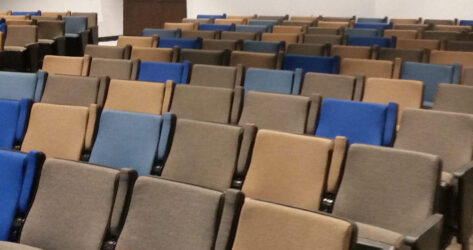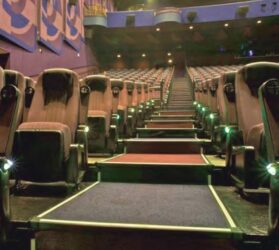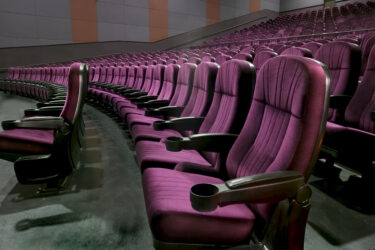Visibility Factors: How To Give Your Audience a Great Visual Experience
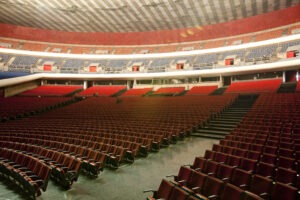 Imagine showing up to a much-anticipated performance—maybe it’s a riveting stage play, a dazzling dance recital, or the big game of the season. You settle into your seat, the lights dim, anticipation rises… and then it happens. Someone’s head blocks your view. You crane your neck. You shift left, then right. You sit forward. It’s no use. Your once-exciting outing has turned into a frustrating game of musical chairs.
Imagine showing up to a much-anticipated performance—maybe it’s a riveting stage play, a dazzling dance recital, or the big game of the season. You settle into your seat, the lights dim, anticipation rises… and then it happens. Someone’s head blocks your view. You crane your neck. You shift left, then right. You sit forward. It’s no use. Your once-exciting outing has turned into a frustrating game of musical chairs.
This scenario, sadly all too common, illustrates one of the biggest sins of poor seating design—bad visibility. Whether you’re talking about bleachers at local stadiums or grandstands at a professional venue, guest visibility makes or breaks the experience. Sightlines are everything.
In this article, we’ll unpack how to give your audience the best visual experience possible—how to plan seating with precision, how to balance safety and comfort, and how to make sure everyone, from the front row to the back of the grandstands, leaves happy.
Understanding the Purpose of the Space
Before you even place the first bolt in a row of bleachers, pause. Ask yourself a crucial question: What is this space going to be used for?
Not all venues serve the same function. A dance theater, for example, demands that every single guest can clearly see the dancers’ footwork. Missing those intricate movements because a seat was poorly placed? That’s not just inconvenient—it’s a deal-breaker. Now think about movie theaters. Here, the screen is typically elevated, so the visual line shifts. You don’t need to see the floor—you need a clear, strain-free view of the screen, no matter where you’re seated.
This is where thoughtful seat positioning comes into play. In stadiums, bleachers might need to rise steeply to allow fans to see over each other’s heads. In theater-style grandstands, different seat inclines and back angles will need to adapt to the viewer’s natural eye level. Knowing what the audience is watching informs everything.
And here’s the kicker—people notice the difference. Poor visibility leaves a lasting impression, and not the kind you want.
Staggering Seating for Clear Sightlines
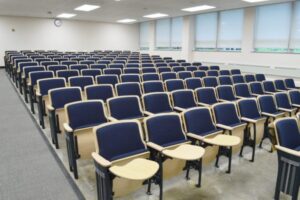 Let’s talk about the technical heart of the matter—staggering. Not the kind that involves clumsy dance moves, but strategic, calculated seat placement that optimizes what each viewer can see.
Let’s talk about the technical heart of the matter—staggering. Not the kind that involves clumsy dance moves, but strategic, calculated seat placement that optimizes what each viewer can see.
You’ve probably noticed it in auditoriums: seats aren’t usually lined up in perfect rows. Instead, they’re offset—slightly shifted left or right in each row. Why? Because if everyone sits directly behind the person in front of them, the view gets blocked. Enter staggered seating.
One popular method is the sawtooth stagger. It’s simple: shift each seat in alternating rows by half a chair, or one quarter to each side. This clever layout significantly improves visibility. Even in auditoriums with a gentle slope, this pattern gives your guests a better line of sight.
Another, less common but effective method is the odd-even parallel system. Here, the number and size of chairs vary between rows—say, alternating 11 twenty-inch chairs with 10 twenty-two inch chairs. While this isn’t practical in every space (especially those with fewer seats per row), it can be surprisingly effective in mid-size spaces.
And if you’re working with a venue that allows for elevation—hello, steep stadiums!—you can often reduce or eliminate staggering altogether. If each row is high enough for someone to see over the person in front of them, it creates a cleaner, more unified look without sacrificing sightlines.
Bottom line? There’s no one-size-fits-all solution. But the right stagger strategy, tailored to your space, is a game-changer. Choose an auditorium seating supplier like Preferred Seating to have a seating plan done for free.
Seating Safety, Comfort, and Flow in Auditoriums
Visibility isn’t just about what people can see. It’s about how comfortably they can see it—and how easily they can get to and from their seats without disrupting everyone else.
Ever tried climbing over a dozen knees to get to your seat in the middle of a packed row? Not fun. People need to get in and out of their seats with ease. Accessibility and safety are huge, especially in large stadiums or grandstands.
This means wider aisles, clearly defined walking paths, and smartly positioned seats. Rows should be spaced to allow movement without interfering with the view. In smaller venues or community bleachers, this could mean adding more rows with fewer seats. In larger arenas, it might mean tiered platforms that allow for both movement and sightline clarity.
And don’t forget the chairs themselves. The best seat in the house isn’t just about the view—it’s about comfort. Are the backs high enough to support? Are they angled appropriately so viewers aren’t straining their necks? Angled seating, especially in the front of the space, can make a massive difference for guests who would otherwise have to look straight up at the action.
Aisle Lighting: Safety Without Distraction
 Here’s a tricky balance: how do you light an aisle enough to keep people safe, but not so much that it distracts from the performance?
Here’s a tricky balance: how do you light an aisle enough to keep people safe, but not so much that it distracts from the performance?
Aisle lighting is more than an after thought—it’s an essential component of great venue design. Too dim, and people trip or struggle to navigate in the dark. Too bright, and the ambiance is ruined. The solution? Smart lighting.
LED aisle lighting has become the gold standard. Why? Because it’s subtle, energy-efficient, and gives off virtually no heat. Plus, it can be placed precisely where it’s needed—at foot level, beneath seats, or along stair edges—casting a gentle glow that guides without overwhelming.
Options like Focal or Beacon lights shine down from mounted panels, illuminating just the walking surface. Or, go for Concealed LED Aisle Lights, which hide beneath seat arms or panel edges, almost invisible during a show. Both styles maintain safety standards while preserving the immersive experience of a performance.
However, every space has its quirks. You’ll need to consider step height, aisle width, and compliance with ADA regulations. Some lighting options might not work with flip-up seats or writing tablets, so double-check compatibility. The good news? With a little planning, even the smallest venues can offer lighting that’s both functional and elegant. Consult with our seating experts at Preferred Seating about seat and aisle lighting.
The Bigger Picture: Designing Auditoriums With Intention
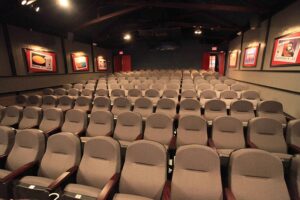 All of these elements—seat stagger, visibility, lighting, accessibility—are puzzle pieces in a larger picture. When they come together, they create a space that not only looks good but feels good.
All of these elements—seat stagger, visibility, lighting, accessibility—are puzzle pieces in a larger picture. When they come together, they create a space that not only looks good but feels good.
Let’s say you’re redesigning a community theater. You want crisp lines, coordinated materials, and a cohesive appearance. But you also need to accommodate diverse audiences: seniors who need extra space, children who need booster seats, performers who need to move through the crowd. It’s not just about cramming in more seats. It’s about crafting an experience.
In grandstands and stadiums especially, where thousands of people gather, this design philosophy is critical. Don’t fall into the trap of thinking more seats equal better design. Strategic seat count, smart sightlines, well-planned access, and a few thoughtful touches—like subtle lighting and comfortable angles—elevate the space.
Think of it like composing music. Every note matters, but harmony is what stirs the soul.
Wrapping It Up: Great Visibility Makes Great Memories
At the end of the day, creating excellent visibility isn’t just a technical challenge—it’s a gift to your audience. It shows respect. It tells them, “You matter. Your experience matters.”
Whether you’re outfitting local bleachers for Friday night lights, fine-tuning grandstands at a county fair, or designing world-class stadiums for major league games, remember this: great design doesn’t just fill space. It transforms it.
So next time you’re walking through a venue, look around. Are the views clear? Can everyone see what they came to see? If not, it’s time for a change.
Invest in better sightlines, smarter layouts, and lighting that’s as thoughtful as it is beautiful. Because when your audience can see everything clearly, they don’t just watch the show—they remember it.
And isn’t that the whole point? Contact Preferred Seating for your free consultation with the experts.




